| |
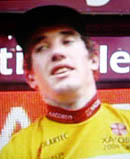
Nozal parait
pouvoir conserver encore son maillot ORO aujourd'hui, mais
attention, c'est la dernière étape de montagne
en ligne

Les premiers échappés au 10ème km.
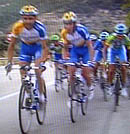
Les banesto impriment un train d'enfer dans le col de los
leones
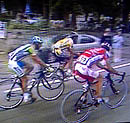
Glez de galdeano est décroché
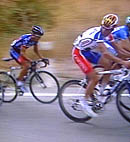
Heras, ici avec Perez se porte en tête du peloton averti
de la situation
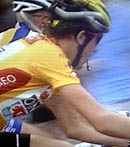
Nozal est encore dans le peloton de tête
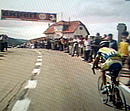
A l'avant Moller passe en tête au col de los Leones
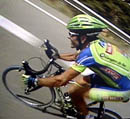
Moller insiste dans la descente, mais il se laisse reprendre
avant la plaine
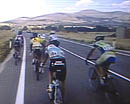
le groupe de tête dans la plaine avant La Pradera
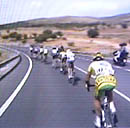
toujours regroupés en tête

Valverde est sorti du peloton avec Cardenas Perez et d'autres
coureurs, ils sont repris
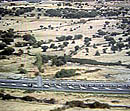 Paysage au pied de la Sierra de Madrid
Paysage au pied de la Sierra de Madrid
 le Peloton passe au 3 ème sprint intermédiaire
le Peloton passe au 3 ème sprint intermédiaire
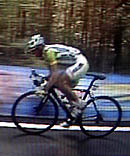 A l'avant Constantino Zaballa a attaqué
A l'avant Constantino Zaballa a attaqué
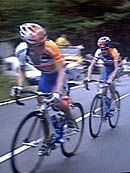 Leipheimer et Rasmussen tente un sortie, mais sont repris
par le peloton
Leipheimer et Rasmussen tente un sortie, mais sont repris
par le peloton
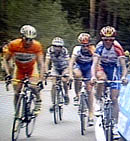 En tête de peloton les favoris se postent en tête
dans le col de Navacerrada
En tête de peloton les favoris se postent en tête
dans le col de Navacerrada
Ici Cardenas, Scarponi, Rasmussen, Perez.
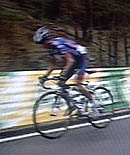
Profitant de l'attentisme des hommes en tête de peloton,
Heras attaque
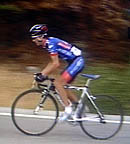
Heras dans le dernier col, un groupe de coureurs se joint
a lui dont Valverde, le groupe va rouler après le sommet
pour conserver le maximum d'écart avec le groupe Nozal.
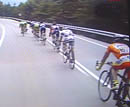 La tête de course de nouveau regroupée
La tête de course de nouveau regroupée
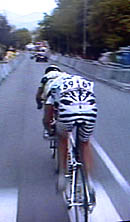 Moller et simeoni sont sortis
Moller et simeoni sont sortis
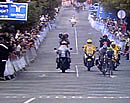 La ligne d'arrivée au bout de la ligne droite
La ligne d'arrivée au bout de la ligne droite
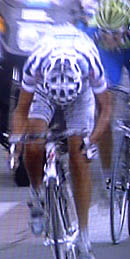 Simeoni lance le sprint
Simeoni lance le sprint
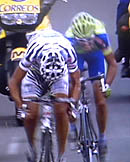 Simeoni toujours
Simeoni toujours
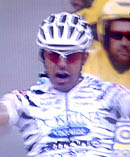 Victoire de Simeoni
Victoire de Simeoni
 Simeoni
laisse éclater sa joie Simeoni
laisse éclater sa joie
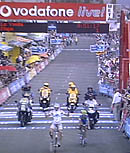 La ligne d'arrivée
La ligne d'arrivée
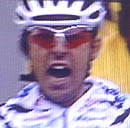 SIMEONI, le coureur victorieux de la Domina Vacanze
SIMEONI, le coureur victorieux de la Domina Vacanze
|
|
|
Commentaire:
Today's
166 km long stage ending in Collado Villalban and containing
two 1st category climbs, played out as a kind of two pronged
drama. On the one hand was the question of who would actually
win the race, and on the other the amount of damage Heras could
inflict on overall leader Nozal.
Only
10km into the race, a group of 19 had already broken away, and
by the time the course reached the first major pass at the 84km
point (the Alto de San Lorenzo del Esvorial), the group held
a 6'30" advantage.
None
of the principle players were involved in the escape, and the
peloton remained relaxed about the situation, although there
continued to be a lot of activity in the front, with new pursuit
groups forming and others dropping back into the peloton.
The
major action was expected to be played out on the last ascent,
the 1st category Alto de la Navacerrada, an 11 km long climb
starting 36km from the finish.
As
the race passed through La Pradera and approached Navacerrada,
a group of 4 had distanced itself from the lead group of 11,
and finally overtook Zaballa to lead the race.
The
severity of the climb reduced the group of 4 to 2--Simeoni &
Moller--who now held a lead of just over a minute on the peloton.
Meanwhile,
as the peloton entered the steeper gradients of the climb, Heras,
who had taken no risks earlier in the day, attacked, followed
by Cardenas & Piopoli. Nozal was further back in the peloton
and in no state to respond.
Heras
& Co. gained about a hundred meters before losing their
momentum and being overtaken by the front of the peloton.
As
Nozal continued to weaken from behind, Heras was aware of this
and attacked anew, this time distancing himself from the peloton
all alone. Heras neared the summit, where the crowds were thick
and boisterous; responding to their encouragement, Heras looked
in his element as he stood on his pedals and continued to build
on hid lead over Nozal.
Fortunately
for Nozal Heras ran out of mountain, for if the climb had lasted
another 2 or 3km, Nozal could well have seen his gold jersey
in the hands of Heras.
After
reaching the summit, Nozal rallied noticeably and began the
job of limiting the damage and making upa little lost time,
with the help of his now regrouped teamates. In the end he gave
up 1'13" to Heras today, to hold an overall lead of 1'55"
going into tomorrow's 12km ascending time trial.
Nozal
showed, once again, that whereas he certainly cedes time to
Heras in the more serious phases of the mountains, and in fact
suffers visibly, he doesn't crack; mentally he's very tough.
And, as has been the case in previous days, he gives his time
liberally for post race television interviews, during which
he always seems totally congenial and relaxed, as if this were
an everyday occasion.
The
other drama, of course, had been unfolding on the descent approaching
the line. Heras became part of a large pursuit group going after
Moller & Simeoni, and it looked as if they might catch them
in the last 1 or 2 kilometers, as the gap dropped from 50"
at the 8km mark to 23" at the 3km point. But the pursuers
momentum was lost when Zaballa, going all out, fell on a roundabout,
momentarily putting the group into disarray.
Simeoni
& Moller stayed clear, and in the final sprint it was Simeoni
all the way, a few meters in front of Moller and 16" in
advance of his pursuers, to win in 3:51'18".
The
points competition between Zabel & Petacchi remains unchanged,
as neither of them was in a position to mark points. Valverde,
however, is now just 3 points behind Petacchi and 19 behind
Zabel. It will all be played out Sunday, where Valverde can
count on support from the home crowd in Madrid.
Le
classement de l'étape
1 - SIMEONI
2 - MOLLER
3 - PERDIGUERO à 16"
4 - MORENI mt
5 - ZBERG
6 - CARDENAS
7 - OSA
8 - RASMUSSEN
9 - VALVERDE
10 - SEVILLA
11 - HERAS
le classement
Général
1 - NOZAL
2 - HERAS à 1'55"
3 - GLEZ de GALDEANO à 3' 03"
4 - VALVERDE à 4'06"
5 - MANCEBO à 5'13
6 - BELTRAN à 5'16"
7 - RASMUSSEN à 6'11"
8 - PEREZ à 7'37"
le classement
des grimpeurs
1 - CARDENAS 194
2 - OSA unai 112
3 - HORRACH 101
4 - VALVERDE 88
5 - PEREZ 72
Le classement des points
1 - ZABEL 151
2 - Petacchi 135
3 - Valverde 132
4 - Cardenas 107
5 - Rasmussen 99
Le classement du Combiné
1 - VALVERDE
2 - CARDENAS
3 - RASMUSSEN
Le classement
par équipes
1 - ONCE
2 - IBANESTO à 1'31"
3 - KELME à 19'24"
4 - COFIDIS à 29'54"
5 - EUSKALTEL à 38'
La Vega de Alcobendas
Alcobendas
is said to be placed in a privileged location, in the heart
of a wide net of motorways (M-40, M-50, Colmenar dual carriageway)
and very close to the international airport of Madrid-Barajas.
Thirteen kilometres from Madrid, Alcobendas is one of the
most attractive cities surrounding the capital of Spain; located
at the north of the city, it has a very rich environment and
offers a wide range of metropolitan services.
The people: the citizens in Alcobendas are young people, from
the most different places and social classes and, mainly,
highly trained professionals.
The city: Alconbendas is made up of high buildings, but it
is not a congested city; it is surrounded by green areas and
very well communicated with the surroundings cities.
The new P.G.O.U. will improve the quality of life as well
as will help develop the economic activity of the city.
The environmental development and the improvement of the economic
activity of the city are the main guidelines followed by the
government of this city.
Collado Villalba
Collado Villalba, municipality from Madrid and placed 39 kilometres
from the capital city in the Hoyo de Manzanares range through
the A-6 motorway, becomes one of the main tourist resorts
in Sierra de Madrid.
The Guadarrama river crosses this village that is placed 917
metres high and has a total surface of 26.5 square kilometres;
there are more than 44,000 inhabitants living here nowadays
and it has had an annual average growth rate of 43.8 % during
the last five years thanks to the excellent road and rail
links that lead to this beautiful city and thanks to the good
urban development as well.
This delightful city is placed in a wide hill made up of the
mountain-island of Cabeza Mediana (1,331 metres) and the West
side of the Hoyo de Manzanares range, where we find the famous
top Canto Astial (1,376 metres) with its 926 metre-long branch
where the well-known building of Canal de Isabel II is located.
A bit further away we find the river, the railway track and
the motorway, very close together, following their ways to
the estuary of the Endrinal in the river Guadarrama. In the
old quarter of Collado Villaba we still can see some of the
early features of the original village, built three hundred
years ago by farmers. History As far as we know, the Neolithic
people were the first inhabitants of this area, who left us
the Entretérminos dolmen with a corridor that measures 30
metres in diameter; this dolmen was studied by the marquees
of Loriana whose possessions, mainly lost, were made up of
an axe, a knife, a dagger, a copper lance tip, two stone polished
axes, a silex knife, a silex lance tip, a gold tiara and a
lot of china. Once the Neolithic people had left, the Celts,
mainly two well-known groups of gentiles: AMIA ELARIG and
CANTABER ELQUISME, invaded the area where Collado Villaba
is placed nowadays.
Around the year 220 BC, our ancestors attacked Hannibal on
his way back from Zamora and Salamanca when he was crossing
this mountain range before reaching the river Tajo. Due to
the nearness of this village to the old Roman road that led
the way from Titulcia to Segovia, along which several Roman
tombs were found, Collado Villalba was also invaded by the
Romans as we can see in the name of the village, VILLAE- ALBA,
of clear Roman influence.
From Visigothic times there are no archaeological remains,
but from the Arab times there are several fountains with brick
vaults and some anthropomorphic graves dug out on the rock.
The village was reconquered on the XI century and repopulated
on the XIII century by the people from Segovia, becoming,
thanks to a decision made by the king Alfonso X, a Crown manor
within the group of villages of Real Manzanares. Years later,
it becomes a possession of Infantes de la Cerda, who were
given the Real Manzanares so as they resigned to their right
to the Crown. Its owner, Don Juan de la Cerda, Señor de Gibraleón
gave it to Doña Leonor, King Alfonso X´s lover in exchange
of several of his possessions.
This king, Alfonso X, in his Libro de la Montería (book on
hunting), describes two Royal huntings in this area. The king
suffered from Black Death and died in Algeciras, short after
him Doña Leonor is murdered by the queen Doña María, Don Pedro
I´s mother, who took all her possessions.
The king Pedro is killed by his step brother Don Enrique II,
Doña Leonor´s son, beginning the Trastámara dynasty; it is
one king within this dynasty, Don Juan I, the one who gives
the Real Manzanares to his butler Don Pedro Gónzalez de Mendoza,
in 1383, whose son Don Diego Hurtado de Mendoza, Almirante
de Castilla, inherits it.
Finally, it belongs for a long time to Casa de Mendoza during
the reign of Juan II, who makes, in 1445, Don Iñigo López
de Mendoza the only owner of the Real Manzanares and also
makes him Marqués de Santullana and Conde del Real.
During the reign of Felipe IV, the Real Manzanares becomes
a Villazgo forming an only village together with Alpedrete,
in 1630. In the year 1840, under the reign of Doña María Cristina
de Borbón, Fernando IVI´s fourth wife and Isabel II´s mother,
it becomes a separate village again .
The distant railway station helped create a new centre of
population that kept on rapidly growing for a long time; that
is the way industrialisation and the beginning of the development
took place in our village.
With the arrival of plumbing and therefore water, the process
of development was completed in the 60´s.
|
|